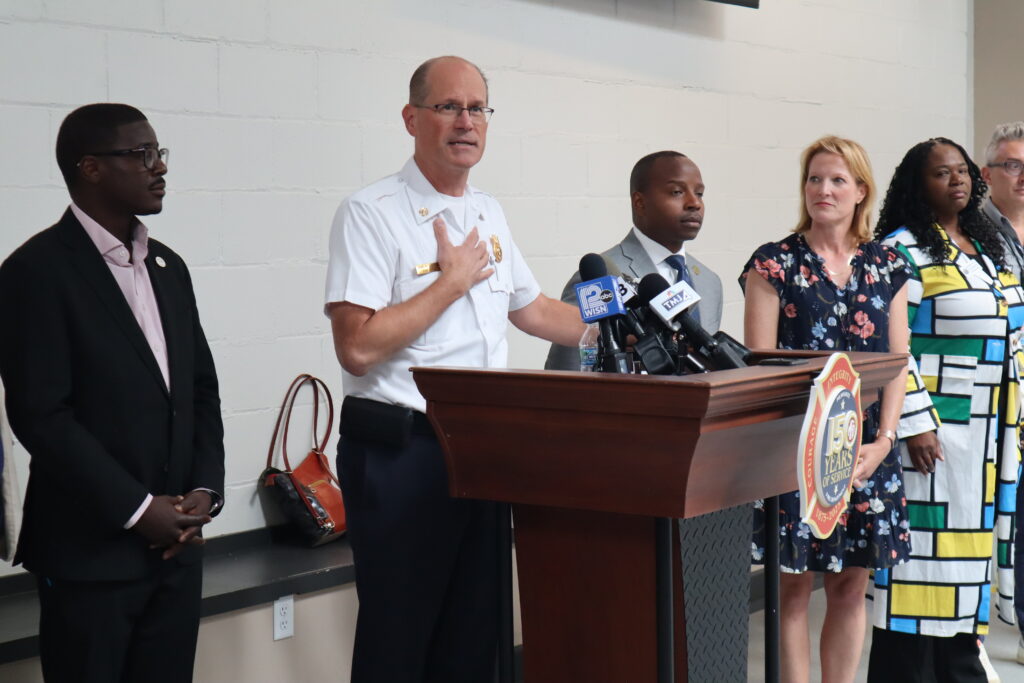City, County Officials Say More Shelters Needed After Floods
Churches, gyms, schools, residents encouraged to open doors to those in need.

Milwaukee Fire Department Chief Aaron Lipski. (Photo by Isiah Holmes/Wisconsin Examiner)
“We’re gathered here today to help people,” said Aaron Lipski, chief of the Milwaukee Fire Department, during a Monday press conference with local and state elected leaders, the American Red Cross and first responders, calling for more volunteers to staff emergency shelters in Milwaukee serving people displaced by unprecedented floods.
Lipski praised the Red Cross as “an amazing partner,” but added, “When we see them feeling the strain, we feel like we should step up and help.”
During the Monday press conference, Mayor Cavalier Johnson said the flood was particularly hard on people who already depend on strained public services, particularly unhoused people in Milwaukee.
As of Aug. 19, more than 3,400 homes were assessed as either destroyed or sustaining major damage from the flooding, which occurred as some parts of Milwaukee County received over 10 inches of torrential downpour. The estimated price tag exceeded $34 million for public property damage.
“Now, we’ve all seen the shock and the tears in the eyes of folks who’ve been affected by those floods,” said Johnson. “The trauma’s enormous, and the sadness is really, really deep,” he added. “… all these folks, they need a place to go — a safe place to go.”
“Now, both these men apparently were unhoused individuals, and that circumstance may have been part of the reason why they ended up losing their lives,” Johnson said. Both men were reportedly known to live in the same encampment under the bridge, near the intersection of South Chase Avenue and South 1st Street. Two other men from the same encampment are reportedly still missing.
“I want all of our neighbors to be sheltered, and to be sheltered safely,” said Johnson. “I want everyone within the sound of my voice to think, really take into account, about how you might be able to assist.”
Milwaukee officials are calling on local residents to pitch in however they can. Whether by opening the doors of a church or business to become a shelter, or volunteering at an existing shelter. The Milwaukee Public Schools district has provided emergency shelter space, Johnson said, but that will be coming to an end in just a few days when the new school year starts.
Catherine Rabenstine, CEO of the American Red Cross of Wisconsin, said that after disasters, “one of the most urgent needs is a safe place to stay,” somewhere that “people can catch their breath, gather their thoughts, and begin to recover.” Many people who were displaced by the floods can only find shelter space far from their own neighborhoods, schools, jobs and support systems, she said. “It makes an already difficult time even harder.”
While the Red Cross has 14 shelter partner facilities across Milwaukee County, only two are located on the North Side “where most apartment fires occur, and where flooding recently hit the hardest,” said Rabenstine. “We need to grow this network, so that no family has to wait for safety.”
Crowley, who has worked to create more affordable housing opportunities, said the flood’s impact has rippled out to touch other areas of need in the community.
“This has really shown … that we have a huge need for housing just in general,” he said. “ … whether we’re talking about people being displaced due to the natural disaster, or people being displaced due to evictions or not having enough money to actually make their rent,” Crowley told Wisconsin Examiner, “I think this shows that we need greater partnership between municipalities, with the state, as well as the federal government to really focus on housing issues.
Scientists have long warned that more intense rainfall and greater flood risks would be among the ways climate change would affect Wisconsin. Rep. Supreme Moore Omokunde, who has worked on climate change legislation, told the Examiner, “We know that when you have fossil fuels that are burning, and they’re going into the air, it causes heavier rains. And we have to cut down our carbon emissions. If it’s not more evident with these kinds of floods, it needs to be more evident now.”
Omokunde said that Wisconsin should focus on ways to capture carbon and support legislation to cut carbon emissions in half by 2030 and achieve net-zero by 2050. “So let’s come to the table, and come up with a plan to say that we need to reduce our greenhouse gas emissions,” he said.
Sen. LaTonya Johnson said that although the Legislature is on break, conversations are happening around the flood aftermath. Officials are also waiting to see how the federal government assesses the damage in Milwaukee, and whether additional federal assistance will be approved. “It’s still a huge concern for us, even with FEMA’s involvement,” Johnson told Wisconsin Examiner.
While touring damage with Gov. Tony Evers, Johnson said she saw houses that had been completely washed off their foundations. ‘There is no salvaging those properties for some of those homeowners, but they still have mortgages,” she said. “So what happens to those dwellings? And we know that even if FEMA does step up, their job isn’t to make people 100% whole. So what does that look like for some of those homeowners and landlords, and how do they get those properties back on the market?” With affordable housing already scarce in Milwaukee and Wisconsin, Johnson wonders what will happen “with even more houses taken off the market” due to flood damage.
Milwaukee officials pushing shelter space for people displaced by floods was originally published by Wisconsin Examiner
If you think stories like this are important, become a member of Urban Milwaukee and help support real, independent journalism. Plus you get some cool added benefits.
More about the 1000 Year Storm
- Wisconsin Emergency Management August Flood Response and Recovery a Team Effort at Wisconsin Emergency Management - Wisconsin National Guard Public Affairs - Dec 23rd, 2025
- New 24-Hour Precipitation Record Confirmed for Wisconsin - Press Release - Dec 19th, 2025
- HUD Delivers Disaster Aid, Financial Flexibility for Wisconsin Residents Impacted by Natural Disasters - U.S. Department of Housing and Urban Development - Nov 26th, 2025
- Gov. Evers Urges Trump Administration to Reverse Course on Denying Wisconsin Communities Disaster Relief for Damage Caused by Extreme Weather in August - Gov. Tony Evers - Nov 19th, 2025
- One Week Left to Apply for FEMA Individual Assistance and SBA Disaster Loans - David Crowley - Nov 5th, 2025
- U.S. Small Business Administration Extends Deadline for Physical Damage Loans for Wisconsin Businesses, Residences, and Private Nonprofits Impacted by August Severe Weather - Gov. Tony Evers - Nov 4th, 2025
- After Another Denial of FEMA Aid, Congresswoman Gwen Moore Urges Reconsideration - U.S. Rep. Gwen Moore - Oct 30th, 2025
- Trump Administration Denies More Disaster Aid for Wisconsin - Graham Kilmer - Oct 29th, 2025
- Trump Administration Denies Hazard Mitigation Funding for Wisconsin Communities After Denying Public Assistance Relief - Gov. Tony Evers - Oct 29th, 2025
- Two Weeks Remain to Apply for FEMA Assistance for August floods - Wisconsin National Guard Public Affairs - Oct 29th, 2025
Read more about 1000 Year Storm here
Political Contributions Tracker
Displaying political contributions between people mentioned in this story. Learn more.
- August 13, 2015 - Cavalier Johnson received $25 from David Crowley





















